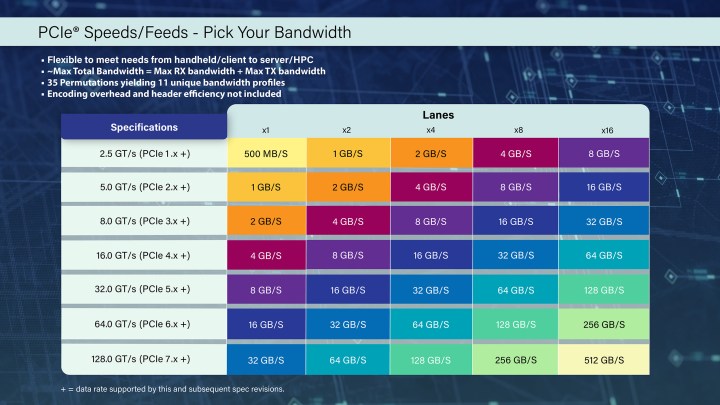PCI-SIG has just announced that the next-gen PCI Express 7.0 specification is already underway. Technical workgroups are now beginning the development of the PCIe Gen 7.0 spec, set to release in 2025.
PCIe 7.0 will double the data transfer rate compared to the previous generation, bringing it up to a staggering 128 gigatransfers per second (GT/s). Meanwhile, PCIe Gen 5.0 SSDs are still very scarce.

PCI-SIG, the consortium that manages the PCI specifications and maintains them as open industry standards, unveiled PCIe Gen 7.0, promising previously unseen data transfer rates. Part of PCI-SIG’s mission is to double the in/out bandwidth every three years, and so far, that has been the case.
The current generation, PCIe 5.0, caps out at 32GT/s. The generation that will follow it, PCIe 6.0, will max out at 64GT/s. Now, we know for a fact that the next-next gen, PCI Express 7.0, will reach previously unimaginable heights by delivering a raw bit rate of 128GT/s as well as 512GB/s bi-directionally through an x16 configuration.
While the 128GT/s bit rate is certainly impressive, PCI-SIG has thrown a few other updates into the mix. The seventh iteration of PCIe has some other goals to meet, such as utilizing pulse amplitude modulation with 4 levels (PAM4) signaling. This modulation scheme takes two bits and then combines them into a single symbol that has four amplitude levels, and, as a result, can double a network’s data rate. It’s also the recommended modulation format required to implement 400-gigabit Ethernet interfaces.
Aside from implementing and optimizing PAM4, PCIe Gen 7.0 has to remain on-point when it comes to maintaining low latency combined with high reliability. PCI-SIG also wants to improve its power efficiency, zone in on the channel parameters and reach, and lastly, maintain backward compatibility with all of the previous generations of PCI Express.
It’s not surprising that with this kind of expected performance, PCIe 7.0 is not targeting the average consumer. According to the press release, the specification is being made to support emerging applications, such as 800G Ethernet, artificial intelligence and machine learning, as well as cloud and quantum computing. The new spec will also find its way to some of the most compute-intensive markets, such as hyperscale data centers, military/aerospace computing, and other types of high-performance computing (HPC).

That’s a hefty list of goals to meet, but there is still quite a bit of time for all of this to come to life. As far as the PCIe adoption on the consumer market goes, it hasn’t been all too fast. Although the current generation is, in theory, PCIe 5.0, such SSDs are still scarcely available. On the other hand, the few of them that have already made it to market are intensely fast, reaching 13,000MBps read speeds.
Intel’s Alder Lake platform supports PCIe 5.0, but PCIe 4.0 is still the go-to. However, as AMD is soon set to release its next-gen Zen 4 processors with PCIe 5.0 support, we are likely going to see a lot more PCIe 5 options amongst the best SSDs.




